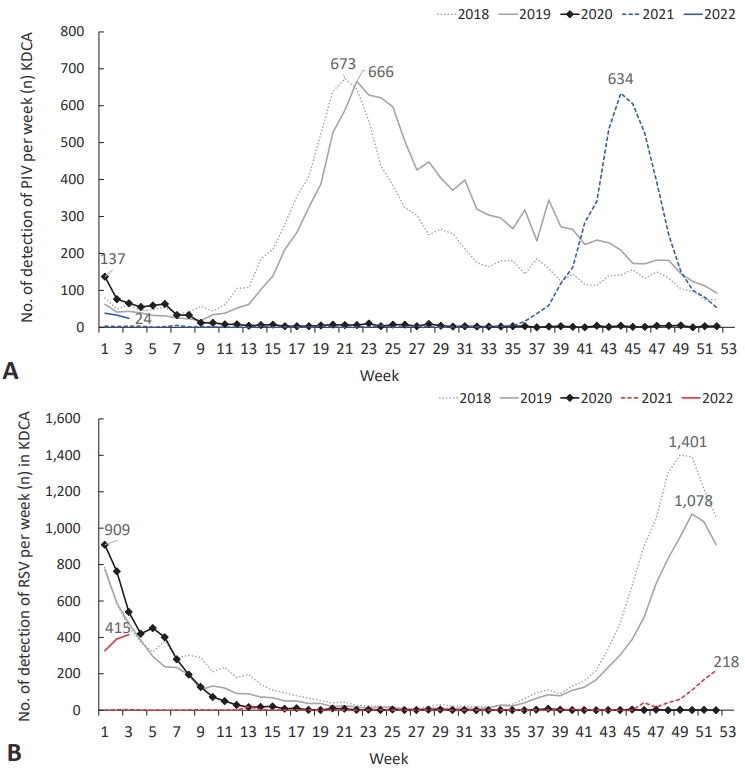All issues > Volume 65(6); 2022
Changes in epidemiology of parainfluenza virus and respiratory syncytial virus infection during coronavirus disease 2019 pandemic in Korea
- Corresponding author: Yae-Jean Kim, MD, PhD Department of Pediatrics, Samsung Medical Center, Sungkyunkwan University School of Medicine, 81 Irwon-ro, Gangnam-gu, Seoul 06351, Korea Email: yaejeankim@skku.edu*†
- Received December 9, 2021 Revised January 30, 2022 Accepted February 22, 2022
To the editor
Coronavirus disease 2019 (COVID-19) pandemic caused significant changes in the epidemiology of other respiratory viruses. Several respiratory viruses with yearly epidemics almost disappeared from the community in most countries in 2020. Yeoh et al. [1] reported a decrease in respiratory syncytial virus (RSV) detections during the COVID-19 pandemic in 2020 in Australia. However, Ohnishi and Kawano [2] reported an atypical RSV season in Japan in 2021 in which they observed increased RSV-associated hospitalization during early summer (weeks 15–23) in 2021 while there was scarcely RSV in 2020.
We analyzed the changes in epidemiology of parainfluenza virus (PIV) and RSV at Samsung Medical Center, a tertiary hospital in Korea, from January 2018 to mid-January 2022. Data were extracted from the Clinical Data Warehouse Darwin-C for this study. Before the COVID-19 pandemic, PIV (mainly PIV3) detection started to increase at week 15 and peaked at weeks 19–28 (May-June), and then slowly decreased until week 45, while RSV detection started at week 38 and peaked at weeks 45–52 (November–December) in 2018 and 2019, respectively (data not shown). PIV and RSV almost disappeared from the community in Korea during the COVID-19 pandemic in 2020. In 2021, however, PIV detection has been increasing rapidly since week 39 (September), peaked at week 44, and then decreased sharply (data not shown). Of interest, RSV detection was observed since week 43 (data not shown) and appeared to further increase in early January of 2022. This RSV epidemiology is somewhat different from what was observed in Japan, the neighboring country at the same time zone [2]. These trends of PIV and RSV epidemiology are also observed at a national level in the report of the respiratory virus surveillance system of the Korea Disease Control and Prevention Agency (Fig. 1A, B) [3]. PIV and RSV infection mainly occurred in the 0- to 4-year age group during the entire observation period (Jan 2018 to Jan 2022) (Table 1).
During the COVID-19 pandemic, after 1 year of disappearance in 2020, the PIV season came back but was shifted from spring to autumn, and the circulating duration was shortened in 2021. RSV season also disappeared in 2020, and the beginning of RSV season was observed again in 2021 but was also slightly shifted from autumn to early winter. With the COVID-19 pandemic, changes in the epidemiology of other respiratory viruses are dynamic according to the timeline. Therefore, continuous surveillance and observation on epidemiological changes in childhood respiratory viruses are needed during the COVID-19 pandemic and in the postpandemic period.
Key message
Key message
Question: How the epidemiology of other childhood respiratory viruses has changed during coronavirus disease 2019 (COVID-19) in Korea?Finding: Parainfluenza virus (PIV) typically circulated in the spring, and respiratory syncytial virus (RSV) epidemic started in autumn in Korea before COVID-19 pandemic. PIV and RSV seasons disappeared in 2020 and came back in 2021 with atypical seasonality. PIV season was changed from spring to autumn, and the beginning of RSV season was slightly delayed from autumn to early winter in 2021.Meaning: Circulation of PIV and RSV was changed to unusual seasons and patterns during COVID-19 pandemic period.
- Footnotes
-
Conflicts of interest YJK received research grants from Ansun Biopharma, AstraZeneca, Merk Sharp & Dohme Corporation, and Janssen Pharmaceutical Company of Johnson & Johnson. YJK is a scientific advisor to Sanofi Pasteur. Execpt for that, no potential conflict of interest relevant to this article was reported.
Funding This study received no specific grant from any funding agency in the public, commercial, or not-for-profit sectors.
-
Fig. 1.
The change of epidemics of parainfluenza virus and respiratory syncytial virus from January 2018 to week 3, 2022 in Korea. (A) PIV season disappeared in 2020 but started from week 37 and declined sharply after peaking at week 44 in 2021.(B) RSV season disappeared in 2020 but started from week 46 in 2021. PIV, parainfluenza virus; RSV, respiratory syncytial virus; KDCA, Korea Disease Control and Prevention Agency.

Table 1.
Detection of the respiratory viruses by age from 2018 to week 3, 2022 in Samsung Medical Center
- References
- 1. Yeoh DK, Foley DA, Minney-Smith CA, Martin AC, Mace AO, Sikazwe CT, et al. Impact of coronavirus disease 2019 public health measures on detections of influenza and respiratory syncytial virus in children during the 2020 Australian winter. Clin Infect Dis 2021;72:2199–202.
[Article] [PubMed] [PMC]2. Ohnishi T, Kawano Y. Resurgence of respiratory syncytial virus infection during an atypical season in Japan. J Pediatric Infect Dis Soc 2021;10:982–3.
[Article] [PubMed]3. Korea Disease Control and Prevention Agency (KDCA). Laboratory surveillance service for influenza and respiratory viruses [Internet]. Cheongju (Korea), KDCA. 2021; [cited 2021 Dec 6]. Available from: https://www.kdca.go.kr/npt/biz/npp/iss/ariStatisticsMain.do.

 About
About Browse articles
Browse articles For contributors
For contributors

